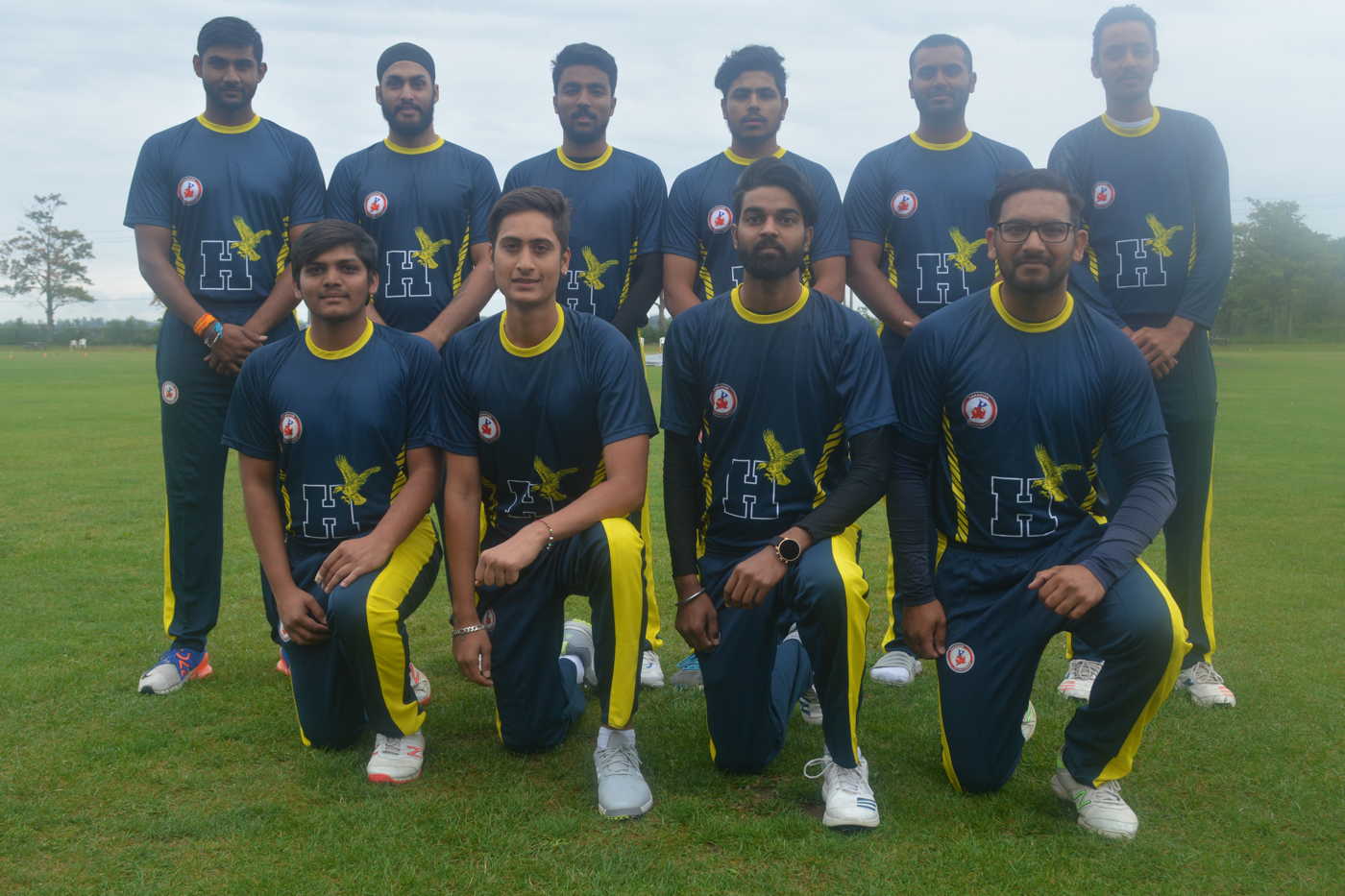 Humber College mens cricket team began Saturday (7 September 2019) with a 27 run semi-final win against Wilfrid Laurier University then captured the Fifth Men’s Canadian College Cricket Championship thanks to a 31-run success under the D/L system against Carleton University in the Final. Humber College posted 168/8 from 20 overs in the final which ended with Carleton University on 107/6 in an innings reduced to 17 overs. Carleton University reached the Final thanks to 31-run semi-final victory against Algonquin College.
Humber College mens cricket team began Saturday (7 September 2019) with a 27 run semi-final win against Wilfrid Laurier University then captured the Fifth Men’s Canadian College Cricket Championship thanks to a 31-run success under the D/L system against Carleton University in the Final. Humber College posted 168/8 from 20 overs in the final which ended with Carleton University on 107/6 in an innings reduced to 17 overs. Carleton University reached the Final thanks to 31-run semi-final victory against Algonquin College.This year’s men’s championship included a record 16 teams, four more than in 2018.
Century Opening Stand Sparks Humber’s Semi-Final Success
Humber College opening bats Emanuel Khohkar (57 from 41 balls) and Parteek Gill (78* from 52 balls) lead the way to an eventual 194/4 after 20 overs with a century stand that ended when Khohkar was caught with Humber College on 100/1 after 12.5 overs. Rohan Kundlass fired a quick 36 from 19 balls, the bulk of a second wicket stand of 46 lasting 4 overs, as Humber progressed to 146/2 from 16.5 overs. Abhishek Sharma clipped 19 runs from 6 balls, helping the total move to 178/3 after 18.4 overs and the innings wrapped up at 194 for 4 wickets from 20 overs.
Wilfrid Laurier University lost a wicket in the opening over, but Bashar Ashfaq and Hamza Yousefzai lifted the score to 83 before Bashar Ashfaq was caught for 42 after 7.2 overs. Humber College tails likely rose when Hamza Yousefzai was caught from the first ball of the tenth for 30: Wilfrid Laurier 91/3 (9.1 overs). Four of the remaining batsmen reached double figures and the scoring rate was around 6 runs per over but below a basic required rate of around 10 runs an over for the second half of the innings. Wilfrid Laurier’s innings ended on 167 after 19.2 overs when a batsman retired hurt and a vacancy for a number 11 batsman.
Carleton Opening Bat Provides Winning Edge against Algonquin
Carleton University opening bat Pavan Vijay Kumar lead the way with 64 runs from 54 balls in an ultimate score of 166 for 9 wickets from 20 overs in the semi-final against Algonquin College. Carleton posted a useful total despite the efforts of Algonquin captain Nabiullah Nawabi whose 4 wickets for 22 runs from 4 overs included the wicket of Pavan Kumar and two of the other three batters to reach double figures.
Algonquin College lost a wicket to the second ball without a run on the board. Opening bat Jaideep Singh went on to reach 49 from 53 balls before being bowled by Ashad Khan to leave Algonquin on 89 for 4 wickets from 14.3 overs. Ashad Khan had earlier bowled Tanveer Singh (78 for 3, 8.4 overs) and followed his disumissal of Jaideep Singh (93/5, 14.6 overs) by having Nabiullah Nawabi caught to leave Algonquin struggling on 97/6. Vikas Verma battled away for 22 runs before being caught off Ashad Khan’s bowling to leave Algonquin on 131 for 7 and the innings closed on 135/8 (20 overs). Ashad Khan’s 4 wickets for 33 runs from 4 overs proved important, as did Gurinderbeer Singh’s 2/18 from 4 overs that included the first and last wickets
of the Algonquin innings. So Carleton University won by 31 runs.
Humber College Win the Crown!
Humber College opening bat Emanuel Khokhar scored 26 from 15 balls in Saturday’s Canadian College Final against Carleton University before being dismissed with Humber 46/2 from 5.4 overs. Captain Rohan Kundlass clipped 21 runs from 25 balls, Abishek Sharma fired 27 runs from 20 balls and Fahad Choudhry garnered 39 runs from 24 balls as Humber College rose to 168/8 after 20 overs. Number 9 bat, Zafar Nauman chipped in 16* from 16 balls and Sauragh Bhagat 7* from 4 balls after Choudry’s dismissal as the end of the innings approached.
Carleton’s Mustafa Popalzai bowled two Humber batters for ducks and ended with 3 for 28 from 4 overs. Haris Waheed 2/27 (4 overs) and Ameed Qadri 2/28 (4 overs) also produced reasonable returns for T20 cricket.
Carleton’s innings was reduced to 17 overs with a target just under the 140-mark before play resumed. Humber College opening bowler Zafar Nauman had one opener caught to end the first over and the new bat was caught during his second over. Humber’s Emmanuel Khokhar bowling economically at the other end. Humber turned to Jasmeet Singh for the fifth over and Zafar Nauman came good as a fielder with the run out of opening bat Usama Shakeel for 14 that put Carleton on 29 for 3 from 4.2 overs. Zafar Nauman had figures of 2/21 from his 2 overs and added to his overall dismissals by catching Ashad Khan for 4 with Navpreet Sidhu bowling the 7th over. So Zafar Nauman was certainly helping to apply the brakes to Carleton’s progress with the bat in the field. Carleton University 34/4 after 6.5 overs. Gurinderbeer Singh, batting at number five, pumped 3 sixes during the 9th over but was silenced next over, caught by Rohan Kundlass off Abishek Sharma for 27 runs (15 balls). The sixth wicket fell a few balls later, then Mustafa Popalzai (34*) and Sohaib Malik (12*) carried Carleton University to a closing 107 for 6 by the end of the 17th and final over of the innings.
Thus, Humber College won the crown of the fifth Mens Canadian College Cricket Championship and the tournament included some new participating Universities and Colleges. One examples of the ups and downs of batting in T20 games might come from Humber College’s Parteek Gill 78* (52 balls) in the semi-final and duck in the final. But as Larry Gomes said before the recent Ontario Regional Under-18 Championship Playoffs, cricket is about the individuals in a team blending together as a team.
Emanuel Khohkar, who played for Canada in the last ICC Under-19 Cricket World Cup, scored 57 (41 balls) in the semi-final and hit a brisk 25 from 15 balls for Humber at the top of the innings in the Final. Humber captain Rohan Kundlass hit 36 (19 balls) in the semi-final and 21 (25 balls) in the final. Kundlass has done well in some of Canadian College Cricket international ventures within the American College Cricket setup.
Building University Cricket to help the National Cricket Scene
Some would ask what kind of a look-in do players from the likes of the Ottawa Valley, Kitchener-Waterloo region or the Windsor area receive within the Ontario cricket scene?
Teams announced for some recent Central Canada T20 and Ontario tournaments have been said to include players from across Ontario, including some from north Ontario. But lists of selected players tend not to mention whether someone bats right- or left-handed or their usual style of bowling and are silent about the player’s main cricket club.
Cricket at St Clair College team was featured in a brief TV news item before this tournament (as can be seen via a link on Canada Cricket Online). The Southern Ontario Cricket Association used to operate a league that included teams from Windsor, Sarnia and the Kitchener-Waterloo area and, in times before I visited any SOCA games (the 2006-2008 era), the league extended into the USA. The league and several cricketers suffered from some of the cross-border travel difficulties that emerged after the events of September 11, 2001.
But, hopefully, through education and sports such as cricket we can build a better world. Canadian College Cricket and American College Cricket have played a number of international series in recent years. Some Canadian Universities and Colleges have also participated in the annual American College Cricket Championships.
Before the setbacks of 9/11 – that on a local level proved a setback for cricket in southern Ontario as previously mentioned – Canada, who first qualified and played in the 1979 Cricket World Cup, began to re-emerge on the international cricketing scene when hosting the 2001 ICC Trophy. Canada took secured a place in the 2003 ICC Cricket World Cup, hosted by South Africa. Canada also played in the 2007 Cricket World Cup, hosted by the West Indies, and 2011 Cricket World Cups hosted by India.
But success has petered out for Canada on the men’s international trail in recent years.
On Wednesday (11 September 2019), Canada’s senior men’s team flew out to Malaysia to play in the first of three six-team tournaments that comprise Cricket World Cup Group A. Canada needs to come top of the standings after paying 15 List-A internationals in order to advance to a World Cup Qualifier that would form the second major step on the stairway to the 2023 Cricket World Cup in India.
Canada’s Under-19 junior men’s team qualified this summer for the 2020 ICC Under-19 Cricket World Cup in South Africa. An ICC Americas XI played in the ICC Under-19 CWC in 2000. Subsequently Canada played in the U19 CWCs in 2002, 2004, 2014, 2016 and 2018 thanks to winning the ICC Americas U19 Championship. Canada U19s also played in the 2010 CWC after winning one of six available spots from a Global U19 World Cup Qualifier that was played in the Greater Toronto Area.
Efforts, such as those by Canadian College Cricket, to develop university and college cricket could play a significant part in expanding the opportunities to play the game competitively for many young players. But there are the challenges of needing to have sufficient people involved
in the organization and operation of such tournaments as well as the need to secure and retain funding.
Securing and retaining funds and sponsorships, other than that via the International Cricket Council which has international performance related-elements, has not been a strength at the national level in Canadian cricket in recent years, nor has it been a strength of cricket’s governing body in Ontario in recent years. Indeed, there seems little evidence that the largest cricketing leagues operating in the Greater Toronto Area have much, if any, league-wide or even top- division sponsorship. There certainly seem to be vacancies for advertising signs around the boundaries at all the cricket grounds I have visited this summer in Ontario.
I suspect those who graduate from Canadian colleges and universities in business management disciplines are more likely to seek their fortunes in businesses beyond the world of GTA, Ontario or Canadian cricket. But there are needs and opportunities, although potential applicants may need to raise funds in order to be able to pay themselves in the “early stages” of building fiscal strength for Canadian cricket from sea to shining sea.
Eddie Norfolk
12 September, 2019

